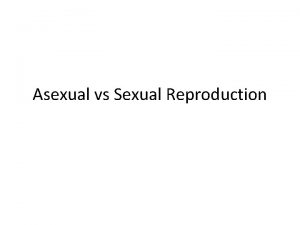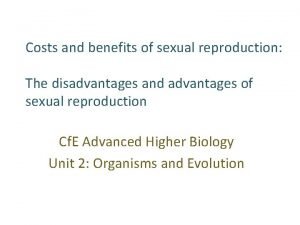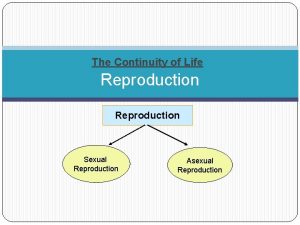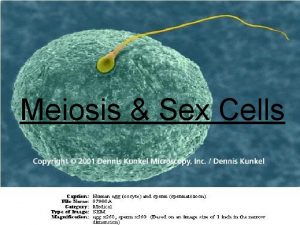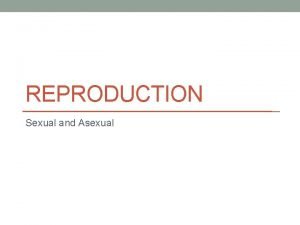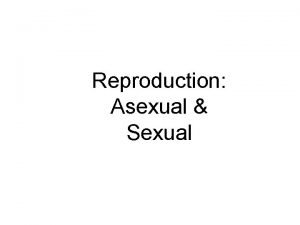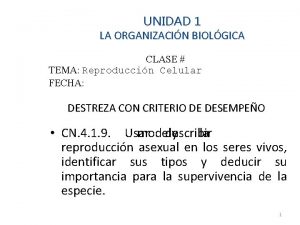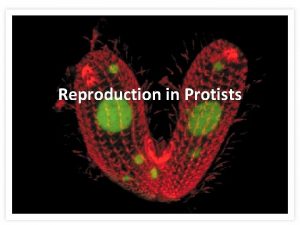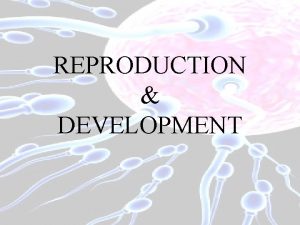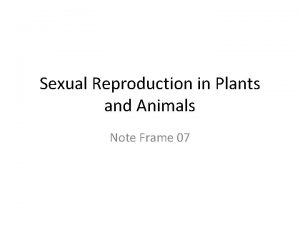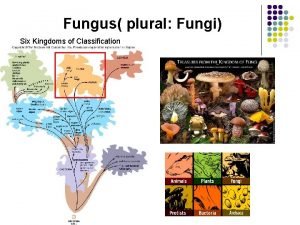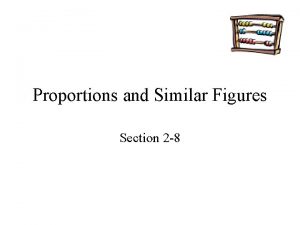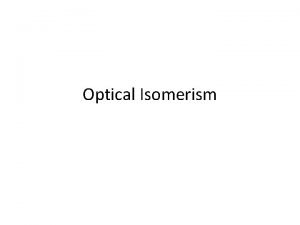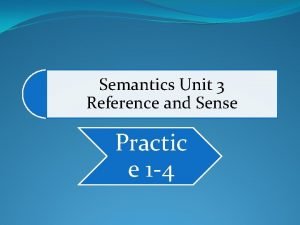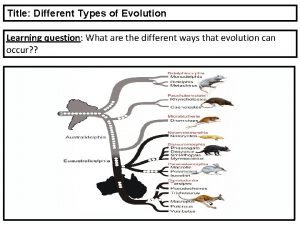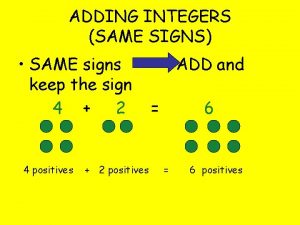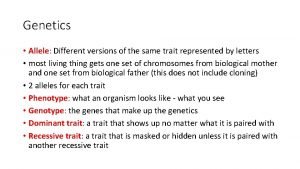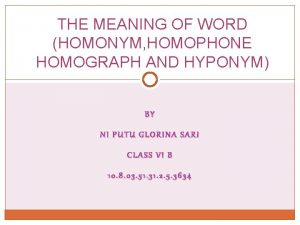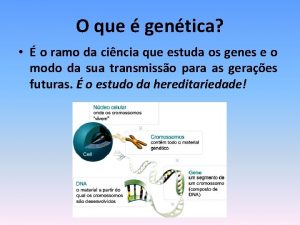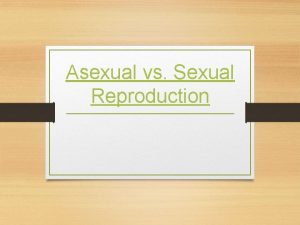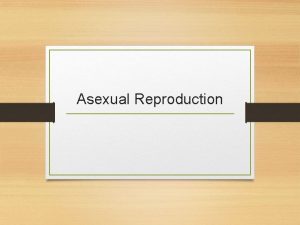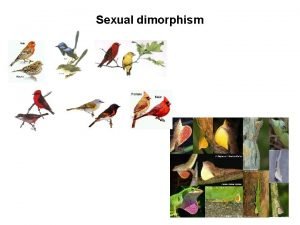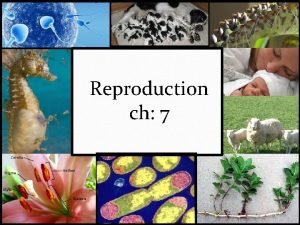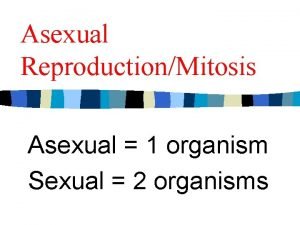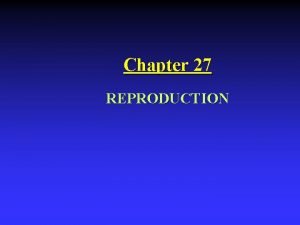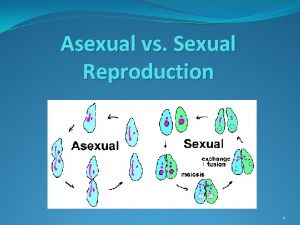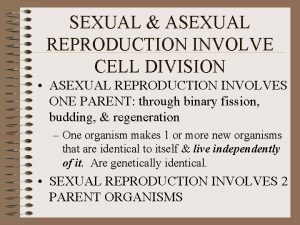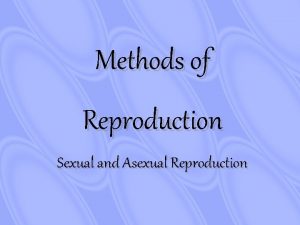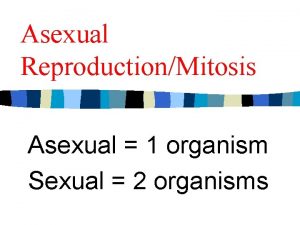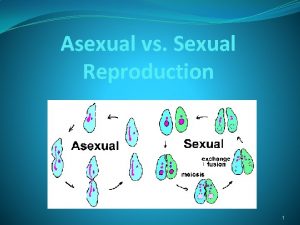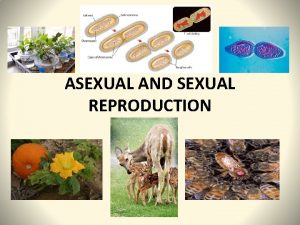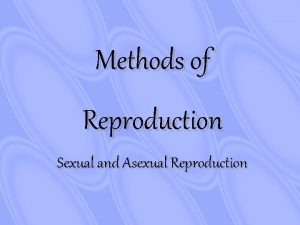Asexual vs Sexual Same or Different Genes Asexual



















































- Slides: 51

Asexual vs. Sexual Same or Different Genes?

Asexual vs. Sexual v Meiosis deals with sexual recombination of genes. v What about Asexual? Do they get a recombination of genes?

Binary Fission v Binary fission, fission is a means of asexual reproduction whereby a parent separates into two or more genetically identical individuals of about equal size.

Asexual-Budding v This is a Hydra. v It forms a little “bud” on its side. v The bud drops off and becomes another hydra. v Does the bud have different or the same genes?

Advantages of Asexual Reproduction v v v Vegetative reproduction is a form of asexual reproduction in plants-no partner & pollen is transferred quickly Fragmentation-broken into 2 or more pieces, and each one grows into a new individual. Conditions have to be favorable. Spores are small and light, and can be carried by wind, water or animals; they can travel far away from the parent, to better conditions. Some spores have thick walls which can give them protection against unfavorable conditions. Because they are so small, the organism can afford to release more of them, so there will be more spores surviving to reproduce elsewhere. .

Parthenogenesis v Reproduction in which an egg develops into a new individual without being fertilized. Aphids and certain other insects can reproduce by parthenogenesis. Parthenogenesis does not necessarily produce clones of the parent. Among hymenopterans such as honeybees and ants, the haploid males develop from unfertilized eggs laid by the queen, who is diploid.

Disadvantages Of Asexual v No Evolution or Adaptations v Diseases are passed down without exception v There will be a struggle for the correct “favorable” conditions in which to reproduce and grow i. e. light, space, nutrients and soil

Advantages of Asexual 1. Large numbers of offspring are reproduced very quickly from only one parent when conditions are favorable. 2. Large colonies can form that can out-complete other organisms for nutrients and water. 3. Large number of organisms mean that species may survive when conditions or the number of predators change. 4. Energy is not required to find a mate.

Advantage of Sexual Reproduction v v v Large chance of an evolution taking place. So, the species would be able to adapt to new environmental conditions. Also new species could be born. Another advantage is that a new character is formed with the mixed gametes of the parents so there is a chance that the parent’s diseases would not be received by the offspring

Disadvantages Of Sexual v Only half the population (females) is capable of gestation v It takes 2. What if you don’t find the other one? v Have to produce gametes(sperm & egg)—what if you don’t? v What if the gametes don’t unite? No guarantees! v Long gestational period and possibly no offspring

Meiosis Chapter 11 Pages 275 -278

Remember Mitosis? v Well, you are going to have to put all of the phases of Mitosis into Meiosis! v Only, there are 2 steps in Meiosis. v So, you have Prophase I, Metaphase I, Anaphase I, Telophase I. Then you have Prophase II, Metaphase II, Anaphase II, and Telophase II. v Fun huh?

Meiosis v The most important thing to remember in distinguishing Mitosis from Meiosis is: v Mitosis deals in body cells (somatic cells) v Meiosis deals with sex cells (Gametes) v Mitosis results in the production of 2 genetically identical diploid cells. v Meiosis produces 4 genetically different haploid cells.

46 Total v Every organism must inherit a single copy of every gene from both its parents. With us, we get 23 from our mom and 23 from our dad. 46 total. v So when you produce your own gametes (sex cells) these 2 sets of genes have to be separated from each other so that each gamete contains just one set of genes.

Homologous v Let’s start with an easier number and separate it. A fruit fly has 8 chromosomes total. 4 from mom and 4 from dad. These chromosomes are homologous, meaning that each male parent chromosome has a corresponding female parent chromosome. (Chromosome 1 from matches up with Chromosome 1 with dad to make the fruit fly. )

Homolgous Chromosomes These chromosomes are numbered 1 -23. Homologous chromosomes come from what your mom and dad donated to you. In the first part of meiosis you divide the WHOLE homologous chromosomes

Diploid v A cell that contains both sets of homologous chromosomes is said to be diploid. v FOUND in SOMATIC CELLS v This means “two sets”. Or 2 N = 46 for us. v Diploid cells contain 2 complete sets of chromosomes and 2 complete sets of genes.

Haploid v In contrast, Haploid cells mean “one set”. v FOUND IN SEX CELLS OR THE GAMETES v The gametes of sexually reproducing organisms, contain only a single set of chromosomes, and only a single set of genes in their sperm or eggs. v Or N = 23 for us.

Questions… v If there are 16 chromosomes in an organisms sperm/egg what is the organisms diploid number? v A haploid gorilla cell contains 24 chromosomes. How many chromosomes would a diploid gorilla cell contain? v A diploid pea plant cell contains 14 chromosomes. How many chromosomes would a haploid pea plant cell contain? v Are eggs and sperm haploid or diploid? v Are your liver cells haploid or diploid?

Meiosis I and II v In Meiosis I—you separate the HOMOLOGOUS Chromosomes v In Meiosis II—you separate the SISTER CHROMATIDS

Meiosis definition v I know what you are going to ask. How are haploid (N) gamete cells produced from diploid (2 N) cells? v Meiosis is the answer! v Meiosis is a process of reduction division in which the number of chromosomes per cell is cut in half through the separation of homologous chromosomes in a diploid cell. (Whew!)

Meiosis v Basically, what that long definition means is that you start with 46 and you divide in half to get 23. v How do we do that you ask? v Meiosis I and Meiosis II. v By the end of Meiosis I, the original diploid cell has become 2 haploid cells. v By the end of Meiosis II, the two haploid cells have become 4 haploid cells each with 1 set of chromosomes.

Video

Interphase Here, you replicate the chromosomes in S phase of interphase. v So if we start with 2 chromosomes in G 1 how many are we going to have in G 2? v 4 v

Prophase I . A LOT happens here! SO PAY ATTENTION! v Here the Homologous chromosomes pair up together v

Tetrad v Before Meiosis, the chromosomes are replicated. (Like mitosis) v In Prophase I of Meiosis I, each chromosome pairs with its corresponding homologous chromosome to form a tetrad. v See Figure 11 -16 page 276 in your book! v I need a volunteer! Any takers?

Tetrad Remember, these are the 2, count them, TWO homologous chromosomes together. BUT, v There are 4 sister chromatids in a tetrad. v Prophase I of Meiosis I is where crossing over takes place! v

Crossing-Over Section 11 -4 Go to Section:

Crossing-Over Section 11 -4 Go to Section:

Crossing-Over Section 11 -4 Go to Section:

Prophase I of Meiosis I Crossing Over v v v There are 4 chromatids in a tetrad. When the homologous chromosomes pair up, they may exchange portions of their chromatids in a process called crossing-over. Crossing over results in the exchange of alleles (one of a number of different forms of a gene) between the same chromosomes and gives new combinations of alleles.

More Crossing Over AKA Recombination of DNA

Metaphase I v Here the homologous chromosomes line up in the middle

Anaphase I v The homologous chromosomes split apart

Telophase 1 v In this phase, like in mitosis the chromosomes are moved into opposite poles and the nuclear envelope reforms and the spindle is broken down. Remember that there are two chromosomes in TWO cells, not one chromosome as in mitosis.

Figure 11 -15 Meiosis Section 11 -4 Meiosis I Interphase I Prophase I Cells undergo a round of DNA replication, forming duplicate Chromosomes. Each chromosome pairs with Spindle fibers attach to the its corresponding homologous chromosomes. chromosome to form a tetrad. Go to Section: Metaphase I Anaphase I The fibers pull the homologous chromosomes toward the opposite ends of the cell.

Meiosis I v If we are still dealing with a 4 chromosome diploid cell, what would the be the end result of Meiosis I? v 2 chromosomes in 2 cells v Are the 2 cells haploid or diploid? v haploid

Meiosis II v The 2 cells then go through another meiotic division. v In Meiosis II neither cell goes through a round of chromosome replication before going through Meiosis II. v The end result of Meiosis II is 4 cells with 2 sister chromatids in them.

Prophase II v In meiosis the cell goes directly from telophase I to prophase II without the interphase. In prophase II the nuclear envelope is again dissolved and the spindle is set up again. Prophase II is identical to prophase of mitosis except that there is half the amount of chromosomes.

Metaphase II v The chromosomes line up in the middle of the haploid cell

Anaphase II v Sister chromatids pull apart

Telophase II v 4 haploid cells with sister chromatids

Figure 11 -17 Meiosis II Section 11 -4 Meiosis II Prophase II Metaphase II Anaphase II Meiosis I results in two The chromosomes line up in a The sister chromatids haploid (N) daughter cells, similar way to the metaphase separate and move toward each with half the number of stage of mitosis. opposite ends of the cell. chromosomes as the original. Go to Section: Telophase II Meiosis II results in four haploid (N) daughter cells.


Questions v Where do new allele combinations form? v Prophase I—Crossing Over v Which stage does each cell have a single copy of a gene? v Telophase II

So what’s the big deal about Meiosis? v It produces GENETIC VARIATION in sexually reproducing organisms! v GENETIC VARIATION!

Oogenesis In females, there is not enough cytoplasm to create 4 eggs at a time. v So, only 1 egg gets produced and the other 3 become POLAR BODIES and get reabsorbed by the ovary. v

Chromosomal Disorders v Non-disjunction v When this occurs, abnormal numbers of chromosomes may find their way into gametes, and a disorder of chromosome numbers may result. v Down’s syndrome is a result of non-disjunction

Nondisjunction Section 14 -2 Homologous chromosomes fail to separate Meiosis I: Nondisjunction Go to Section: Meiosis II

Nondisjunction Section 14 -2 Homologous chromosomes fail to separate Meiosis I: Nondisjunction Go to Section: Meiosis II

Nondisjunction Section 14 -2 Homologous chromosomes fail to separate Meiosis I: Nondisjunction Go to Section: Meiosis II
 Linked genes and unlinked genes
Linked genes and unlinked genes Homeotic genes
Homeotic genes Polygenic inheritance
Polygenic inheritance Argumenterande tal struktur
Argumenterande tal struktur Examples of asexual propagation
Examples of asexual propagation Binary fission in bacteria
Binary fission in bacteria Asexual reproduction cell division
Asexual reproduction cell division Asexual vs sexual reproduction venn diagram
Asexual vs sexual reproduction venn diagram Parthenogenesis in mammals
Parthenogenesis in mammals Sexual or asexual reproduction
Sexual or asexual reproduction Sexual or asexual reproduction
Sexual or asexual reproduction Mitosis and meiosis
Mitosis and meiosis Example of budding asexual reproduction
Example of budding asexual reproduction Sexual or asexual reproduction
Sexual or asexual reproduction What is meiosis
What is meiosis Spores sexual or asexual
Spores sexual or asexual Sexual reproduction
Sexual reproduction Asexual or sexual reproduction
Asexual or sexual reproduction Etapas de la reproducción humana
Etapas de la reproducción humana Asexualk
Asexualk Reproduction of protista
Reproduction of protista Sexual vs asexual reproduction venn diagram
Sexual vs asexual reproduction venn diagram Asexual or sexual reproduction
Asexual or sexual reproduction Asexual and sexual reproduction venn diagram
Asexual and sexual reproduction venn diagram Asexual and sexual reproduction difference
Asexual and sexual reproduction difference Plural form of fungus
Plural form of fungus Similar figures / proportion (level 1)
Similar figures / proportion (level 1) Same place same time
Same place same time Same same
Same same Same place same passion
Same place same passion Similar
Similar Volume bingo
Volume bingo Apa same author different year
Apa same author different year Sense and reference in semantics
Sense and reference in semantics Homologous
Homologous Intext citations apa
Intext citations apa Adding integers with the same sign
Adding integers with the same sign 5 rows and 2 columns
5 rows and 2 columns How do you cite two authors in apa
How do you cite two authors in apa What things make us special
What things make us special Whats a homophone
Whats a homophone Citation for 3 authors apa
Citation for 3 authors apa Different materials have different
Different materials have different Flame test principle
Flame test principle Cultural relativism
Cultural relativism Sound will travel at different speeds in different mediums.
Sound will travel at different speeds in different mediums. Different angle different story
Different angle different story Different faces different places song
Different faces different places song Library.thinkquest.org 19537
Library.thinkquest.org 19537 Why do different polymers have different properties
Why do different polymers have different properties O que é fenotipo
O que é fenotipo Retrocruzamiento
Retrocruzamiento









